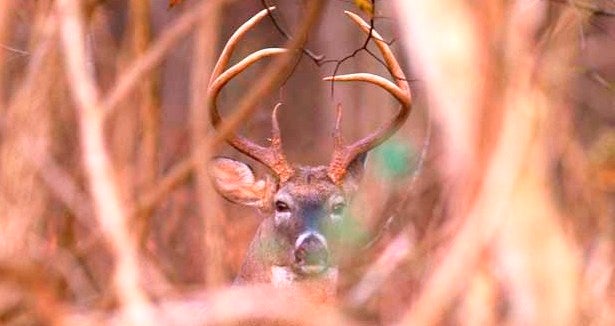Science Of Deer Vision
OutdoorChannel.com 09.26.13

By: Posted 06-17-2013 OutdoorChannel.com in Story by Trey Reid
Permitted use provided by: OutdoorChannel.com.
This is a first in a series of articles looking into the science behind whitetail deer.
It’s a perfectly crisp and clear autumn morning when a whitetailed doe wanders into view beneath your deer stand. Despite a favorable wind, the doe stops dead in her tracks, staring cautiously in your direction, twitching an ear and flaring a nostril. You’re perfectly motionless. The deer stretches her neck and twists her head from side to side. After what seems like an eternity, she eventually turns her attention to the acorns scattered on the forest floor.
Why didn’t she run away? Her scrutiny supports the idea that she saw you, but instead of running for safety, she finally relaxed and started feeding.
It could’ve turned out another way, with some visual cue triggering a flight response and the deer high-tailing it in the opposite direction. With either outcome, the result may be attributed to processes of whitetail vision.
What exactly do deer see? Since the deer can’t tell us, we turn to science for answers.
Wildlife biologists have been studying whitetail vision for years, including a landmark 1992 study by scientists from the University of Georgia, the University of California and the Medical College of Wisconsin. More recently, University of Georgia researchers examined deer vision as part of a study on how to keep deer out of roadways and reduce deer-vehicle collisions.
Although deer-vision research has many purposes, there are obvious implications for deer hunters.
In most vertebrates, the eye works by allowing light to enter and then projecting it onto the retina, a light-sensitive panel of cells at the rear of the eye. The retina’s cone cells, which provide the ability to distinguish color and see detailed focus, and rod cells, which provide low-light contrast, detect light and convert it to neural signals that are transmitted to the brain by the optic nerve.
But all eyes are not created equal. Much of the research into deer vision has compared deer and human vision based on eye structure, and structural differences often mean functional differences.
Humans see a wide range of color as a result of three types of cones in our eyes: one that’s sensitive to short-wavelength light in the blue portion of the color spectrum, one sensitive to middle-wavelength light in the green portion and a third type receptive to long-wavelength light in the red portion.
In contrast to humans’ “trichromatic” vision, deer have “dichromatic” vision because they have only two types of cones, lacking the cone that’s sensitive to longer wavelengths such as red and orange. It doesn’t mean deer don’t see red and orange hues, only that they perceive the colors differently, likely the same way as a color-blind person.
Imagine a bushel basket of tomatoes in various stages of ripeness; while most humans can differentiate the green tomatoes from the pink and red ones, color-blind humans and deer cannot make the same visual distinction. It’s likely deer can discriminate between blue and red but not green and red.
The implication for hunters is that, barring other considerations such as scent and movement, it’s unlikely a deer will bust a hunter who’s wearing a blaze-orange hat and vest. For a hunter wearing a blue shirt under his orange vest, it may be a different story.
Another major difference between human and deer vision is visual acuity, which is the ability to focus on fine detail. Humans have an area on the retina called the optic fovea, a retinal depression with a high concentration of cone cells. Furthermore, about half of humans’ optic nerves are connected to the fovea. This combination gives us the ability to see fine detail, especially for activities such as reading, driving or watching television.
In contrast to a human’s round pupil and concentrated cones on the optic fovea, a deer’s horizontal-slit pupil and retinal structure give them a “visual streak” with areas of concentrated cone cells. As the concentration of cone cells on the retina increases, so does the ability to see detail. Deer have much less concentration of cone cells than humans, which means they don’t see the same fine detail. Research out of the University of Georgia points to deer vision being in the range of 20/200, which means a deer should be able to see detail at 20 meters that a human eye can see at 200 meters. That’s the same as a legally blind person.
Because of the horizontal pupil and cone concentration along the visual streak, scientists believe deer probably see greater detail along a horizontal swath in the middle of their field of vision. For an idea of how this might look from a deer’s perspective, imagine a television screen divided into horizontal thirds, with the screen’s middle section in sharp focus but with the top and bottom thirds blurred.
This may explain the lack of perceived danger by the deer in the hypothetical scenario at the beginning of this article. It also may support notions that hunters in elevated stands have an advantage over hunters on the ground.
Whitetails have built-in advantages over humans in the area of night vision. Their pupils are larger, allowing more light to reach the retina’s light receptors. Deer also have a tapetum, a reflective eye structure that enables whitetails to recycle light. The tapetum acts like a mirror, causing a deer’s eyes to shine at night, and when light isn’t absorbed by receptor cells the first time it enters the eye, the tapetum reflects it back over the cells a second time.
The potential ability to see ultraviolet light is another difference between the human and whitetail eye. Because humans are long-lived animals, we have a colored pigment in the eye lens that helps filter out damaging ultraviolet light, which otherwise might cause our eyes to fail long before the rest of the body. The relatively short-lived deer lacks the ultraviolet filter, possibly allowing deer to see into the UV spectrum. The lack of the filter also likely increases a deer’s ability to see shorter-wavelength light in the blue part of the spectrum. While findings on a deer’s ability to see UV light are inconclusive, research suggests fabrics containing UV dyes and brighteners – common components in most of today’s clothes and laundry detergents – are more visible to deer than to humans.
The implication for hunters is that some fabrics and detergents may cause them to glow as if they were standing under a blacklight.
Next: The Science of Antlers… stay tuned!
